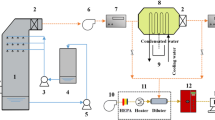Abstract
Heterogeneous condensation of water vapor as a preconditioning technique for the removal of fine particles from flue gas was investigated experimentally in a wet flue gas desulfurization (WFGD) system. A supersaturated vapor phase, necessary for condensational growth of fine particles, was achieved in the SO2 absorption zone and at the top of the wet FGD scrubber by adding steam in the gas inlet and above the scrubbing liquid inlet of the scrubber, respectively. The condensational grown droplets were then removed by the scrubbing liquid and a high-efficiency demister. The results show that the effectiveness of the WFGD system for removal of fine particles is related to the SO2 absorbent and the types of scrubber employed. Despite a little better effectiveness for the removal of fine particles in the rotating-stream-tray scrubber at the same liquid-to-gas ratio, The similar trends are obtained between the spray scrubber and rotating-stream-tray scrubber. Due to the formation of aerosol particles in the limestone and ammonia-based FGD processes, the fine particle removal efficiencies are lower than those for Na2CO3 and water. The performance of the WFGD system for removal of fine particles can be significantly improved for both steam addition cases, for which the removal efficiency increases with increasing amount of added steam. A high liquid to gas ratio is beneficial for efficient removal of fine particles by heterogeneous condensation of water vapor.
Access this chapter
Tax calculation will be finalised at checkout
Purchases are for personal use only
Similar content being viewed by others
References
Sloss LL, Smith IM. PM10 and PM2.5: an international perspective. Fuel Process Technol. 2000;65–66:127–41.
Wang H, Song Q. Experimental study on removal effect of wet flue gas desulfurization system on fine particles from a coal-fired power plant. Proc CSEE. 2008;28(5):1–7.
Meij R. Trace element behavior in coal-fired power plants. Fuel Process Technol. 1994;39(1–3):199–217.
Meij R, Winkel H. The emissions and environmental impact of PM10 and trace elements from a modern coal-fired power plant equipped with ESP and wet FGD. Fuel Process Technol. 2004;85(6–7):641–56.
Yan JP, Yang LJ. Impact property on fine particles from coal combustion in ammonia flue gas desulfurization process. Proc CSEE. 2009;29(5):21–6.
Heidenreich S, Ebert F. Condensational droplet growth as a preconditioning technique for the separation of submicron particles from gases. Chem Eng Process. 1995;34(3):235–44.
Calvert S, Goldschmid J. Feasibility of flux force/condensation scrubbing for fine particulate collection. A.P.T., Inc.; 1973 Report No.: EPA 650/2-73-036. NTIS No. PB 227–307.
Schauer P. Removal of submicron particles from a moving gas stream. Ind Eng Chem. 1951;43(7):1532–8.
Lancaster BW, Strauss W. A study of steam injection into wet scrubbers. Ind Eng Chem Fundam. 1971;10(3):362–8.
Calvert S, Jhaveri NC. Flux force/condensation scrubbing. J Air Pollut Control Assoc. 1974;24(10):946–51.
Johannessen T, Christensen JA. The dynamics of aerosols in condensational scrubbers. Chem Eng Sci. 1997;52(15):2541–56.
Heidenreich S, Vogt U. A novel process to separate submicron particles from gases-a cascade of packed columns. Chem Eng Sci. 2000;55(15):2895–905.
Vogt U, Heidenreich S. Separation of submicron particles in packed columns-optimization and scale-up of the process. Chem Eng Technol. 1999;22(11):935–42.
Yan JP, Yang LJ. Experimental study on separation of inhalable particles from coal combustion by heterogeneous condensation enlargement. Proc CSEE. 2007;27(35):12–6.
Fan FX. Study on growth mechanisms of inhalable particles in acoustic field and in supersaturated vapor environment. PhD dissertation, Southeast University; 2008.
Yang LJ, Zhang X. Analysis of cooperative removal of PM2.5 by heterogeneous condensation in wet flue gas desulphurization. Mod Chem Ind. 2007;27(11):23–8.
Yi HH, Hao JM. Characteristics of inhalable particulate matter concentration and size distribution from power plants in China. J Air Waste Manage Assoc. 2006;56(9):1243–51.
Gerber HE, Hoppel WA. Experimental verification of the theoretical relationship between size and critical supersaturation of salt nuclei. J Atmos Sci. 1977;34(11):1836–41.
Tang IN. Phase transformation and growth of aerosol particles composed of mixed salts. J Aero Sci. 1976;7(5):361–71.
Fan FX, Yang LJ. Numerical analysis of water vapor nucleation on PM2.5 from municipal solid waste incineration. Chem Eng J. 2009;146(2):259–65.
Acknowledgment
The authors thank the High-tech Research and Development Program of China (No.2008AA05Z306), the Natural Science Foundation of Jiangsu Province (NO. BK2008283), and the Scientific Research Foundation of Graduate School of Southeast University for their financial support.
Author information
Authors and Affiliations
Corresponding author
Editor information
Editors and Affiliations
Rights and permissions
Copyright information
© 2013 Springer-Verlag Berlin Heidelberg & Tsinghua University Press
About this paper
Cite this paper
Bao, J., Yang, L., Yan, J., Xiong, G., Shen, X. (2013). Experimental Investigation on Improving the Removal Effect of WFGD System on Fine Particles by Heterogeneous Condensation. In: Qi, H., Zhao, B. (eds) Cleaner Combustion and Sustainable World. ISCC 2011. Springer, Berlin, Heidelberg. https://doi.org/10.1007/978-3-642-30445-3_92
Download citation
DOI: https://doi.org/10.1007/978-3-642-30445-3_92
Published:
Publisher Name: Springer, Berlin, Heidelberg
Print ISBN: 978-3-642-30444-6
Online ISBN: 978-3-642-30445-3
eBook Packages: EnergyEnergy (R0)




